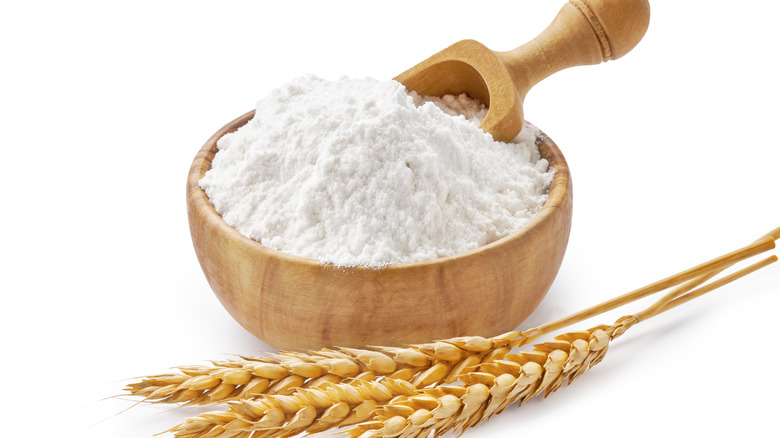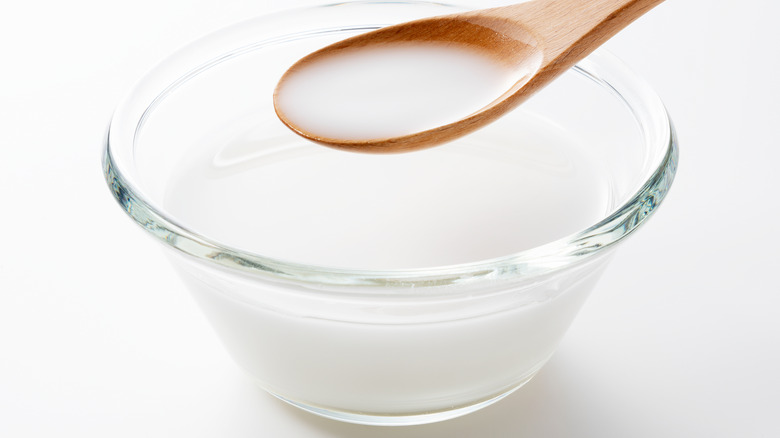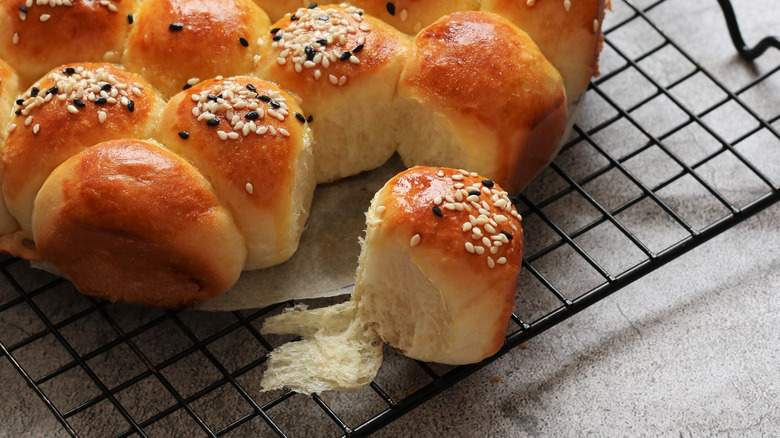What Is Tangzhong And Why Should You Try It Next Time You Bake Bread?
Soft rolls and buns may occupy a niche in western baking, but they are a thing in North Asia and Singapore, where most bakeries feature pillowy-soft buns filled with everything from curried meats to a sweet cream that lend flavor to every bite. Singapore-based pastry chef Daniel Tay says that's not surprising, given that the breads serve up both flavor and nostalgia. "I know it's been trendy to eat crusty bread recently. But are most of us trained to eat that from young? Not to me," he told Michelin.
And while western pastry shops do have their cream buns, dinner rolls, and cinnamon buns, they don't deliver on the softness the way Asian buns do, and Tay says there are a number of reasons for that. "Asian-style bread is high in fat and sugar," he explained. "About 15% fat and 25% sugar. These two work together to give the soft texture."
But there is a third element, which bakers in Japan, Singapore, and Taiwan know to be the "secret sauce" and which not only makes soft rolls spongier, it also keeps them softer, and for much longer: a cooked flour and water slurry known as "tangzhong."
How tangzhong first became popular
While seasoned European bakers might have their sourdough cultures that go back generations, their Asian counterparts have "tangzhong" — but the method used to help yeasted bread rise to the occasion doesn't belong to a centuries-old tradition. King Arthur Baking credits Taiwan writer Yvonne Chen for popularizing the method in a book published in the early 2000s, and whose title roughly translates as "65C Tangzhong Breads." In it, she describes the way bread is made by first cooking up a thick, gloopy slurry with a small portion of the flour and water intended for the recipe and then cooling that down before incorporating that into the rest of the bread ingredients.
While Chen might have been the first person to write about tangzhong in a book, she wouldn't have been the first person to have discovered the method or have made a cooked bread starter that way. A similar method exists in Japanese baking known as "yudane," which also involves making a flour-and-water slurry, but with slight differences that exist between the two.
Difference between tangzhong and yudane
As it turns out, the difference between "tangzhong" and "yudane" is semantic, and both are two different ways to refer to the same thing. In her video, YouTuber Kitchen Princess Bamboo points out that the two refer to "pre-cooked bread flour dough" and that they in fact, are so similar that they share the same name — "tangzhong" and "yudane" are written with the same characters in both Chinese and Japanese Kanji. And while both refer to the use of a flour-and-water starter to make a roux, it is how that roux starts off that sets both methods apart.
King Arthur Baking describes the method of making a tangzhong by mixing flour and water together over medium-high heat until you have what looks like a thick paste or a roux. Once the paste cools to lukewarm, it is combined with the rest of the ingredients. Those who enjoy making choux pastry from scratch will probably recognize the method used to make tangzhong as reminiscent of making a panade (via Serious Eats).
Like tangzhong, yudane is a mix of flour and a liquid heated until boiling. But no stovetop cooking is involved; instead the slurry is mixed off the heat in a 1-to-1 ratio, with the mixture left in the fridge to cool for between 4-8 hours, before it is incorporated into the bread dough (via Asian Inspirations).
How is tangzhong made and used?
Tay says to make a tangzhong, it is best to start with a strong bread flour with 12.5% protein, which is seen as important for gluten development. His tangzhong is built on a 1-to-1 ratio of 100 grams of strong bread flour to 100 ml of water. He suggests boiling the water first, then adding the flour and removing the slurry off the heat to keep it from getting burnt. From there, mixing should continue until a soft dough is created and the slurry is cool. The tangzhong is then added to the rest of the ingredients after they have been mixed ahead (via Michelin).
Tay's proportions vary differently from that used by writer PJ Hamel at King Arthur Baking, who began a tangzhong with three tablespoons of flour and 1/2 cup of milk in a saucepan over medium-high heat. The slurry is then taken off the heat when it thickens, left to cool until it is lukewarm, and then mixed in with the rest of the ingredients to make a sweet dough. King Arthur says a tangzhong is best used in recipes for hot cross buns, a classic sandwich bread, or pull-apart buns. In a separate note, King Arthur Baking says it's important to remember to use quantities of flour and liquid — be it water or milk — that is called for in the recipe, but which is not surplus to requirements.



